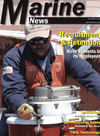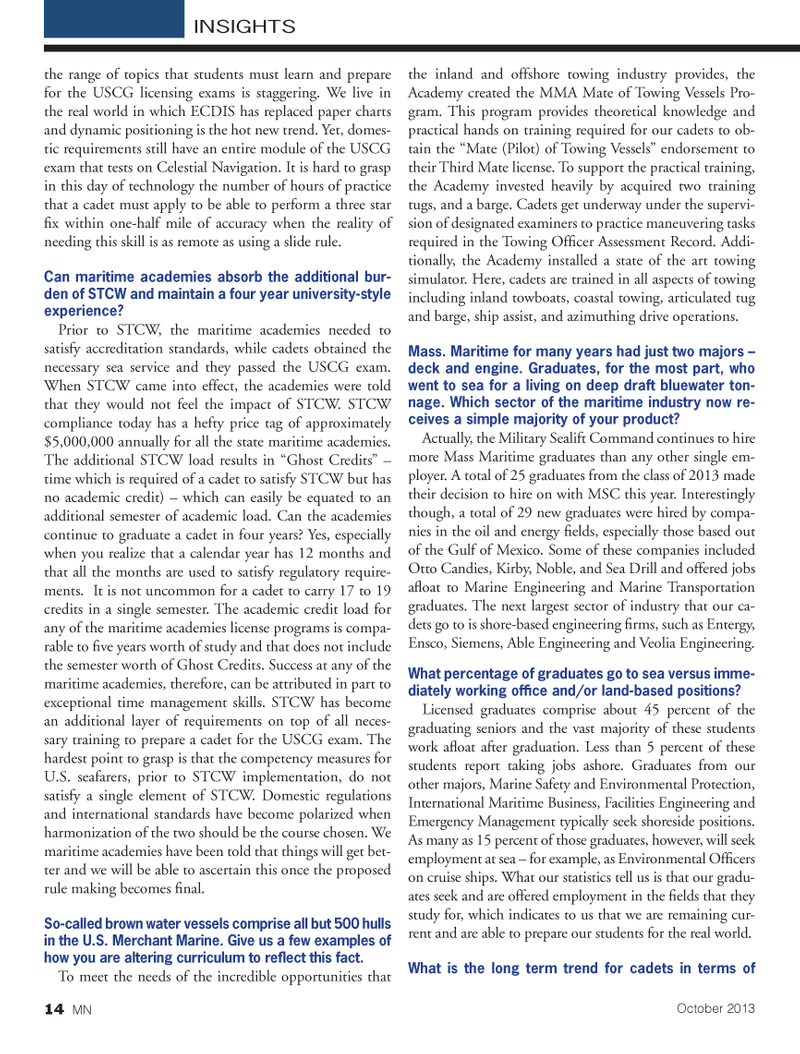
Page 14: of Marine News Magazine (October 2013)
Manning: Recruitment & Retention
Read this page in Pdf, Flash or Html5 edition of October 2013 Marine News Magazine
the range of topics that students must learn and prepare for the USCG licensing exams is staggering. We live in the real world in which ECDIS has replaced paper charts and dynamic positioning is the hot new trend. Yet, domes- tic requirements still have an entire module of the USCG exam that tests on Celestial Navigation. It is hard to grasp in this day of technology the number of hours of practice that a cadet must apply to be able to perform a three star Þ x within one-half mile of accuracy when the reality of needing this skill is as remote as using a slide rule. Can maritime academies absorb the additional bur- den of STCW and maintain a four year university-style experience?Prior to STCW, the maritime academies needed to satisfy accreditation standards, while cadets obtained the necessary sea service and they passed the USCG exam. When STCW came into effect, the academies were told that they would not feel the impact of STCW. STCW compliance today has a hefty price tag of approximately $5,000,000 annually for all the state maritime academies. The additional STCW load results in ÒGhost CreditsÓ Ð time which is required of a cadet to satisfy STCW but has no academic credit) Ð which can easily be equated to an additional semester of academic load. Can the academies continue to graduate a cadet in four years? Yes, especially when you realize that a calendar year has 12 months and that all the months are used to satisfy regulatory require- ments. It is not uncommon for a cadet to carry 17 to 19 credits in a single semester. The academic credit load for any of the maritime academies license programs is compa- rable to Þ ve years worth of study and that does not include the semester worth of Ghost Credits. Success at any of the maritime academies, therefore, can be attributed in part to exceptional time management skills. STCW has become an additional layer of requirements on top of all neces- sary training to prepare a cadet for the USCG exam. The hardest point to grasp is that the competency measures for U.S. seafarers, prior to STCW implementation, do not satisfy a single element of STCW. Domestic regulations and international standards have become polarized when harmonization of the two should be the course chosen. We maritime academies have been told that things will get bet- ter and we will be able to ascertain this once the proposed rule making becomes Þ nal.So-called brown water vessels comprise all but 500 hulls in the U.S. Merchant Marine. Give us a few examples of how you are altering curriculum to reß ect this fact. To meet the needs of the incredible opportunities that the inland and offshore towing industry provides, the Academy created the MMA Mate of Towing Vessels Pro- gram. This program provides theoretical knowledge and practical hands on training required for our cadets to ob- tain the ÒMate (Pilot) of Towing VesselsÓ endorsement to their Third Mate license. To support the practical training, the Academy invested heavily by acquired two training tugs, and a barge. Cadets get underway under the supervi- sion of designated examiners to practice maneuvering tasks required in the Towing OfÞ cer Assessment Record. Addi- tionally, the Academy installed a state of the art towing simulator. Here, cadets are trained in all aspects of towing including inland towboats, coastal towing, articulated tug and barge, ship assist, and azimuthing drive operations. Mass. Maritime for many years had just two majors Ð deck and engine. Graduates, for the most part, who went to sea for a living on deep draft bluewater ton-nage. Which sector of the maritime industry now re- ceives a simple majority of your product? Actually, the Military Sealift Command continues to hire more Mass Maritime graduates than any other single em- ployer. A total of 25 graduates from the class of 2013 made their decision to hire on with MSC this year. Interestingly though, a total of 29 new graduates were hired by compa- nies in the oil and energy Þ elds, especially those based out of the Gulf of Mexico. Some of these companies included Otto Candies, Kirby, Noble, and Sea Drill and offered jobs aß oat to Marine Engineering and Marine Transportation graduates. The next largest sector of industry that our ca- dets go to is shore-based engineering Þ rms, such as Entergy, Ensco, Siemens, Able Engineering and Veolia Engineering. What percentage of graduates go to sea versus imme- diately working ofÞ ce and/or land-based positions? Licensed graduates comprise about 45 percent of the graduating seniors and the vast majority of these students work aß oat after graduation. Less than 5 percent of these students report taking jobs ashore. Graduates from our other majors, Marine Safety and Environmental Protection, International Maritime Business, Facilities Engineering and Emergency Management typically seek shoreside positions. As many as 15 percent of those graduates, however, will seek employment at sea Ð for example, as Environmental OfÞ cers on cruise ships. What our statistics tell us is that our gradu- ates seek and are offered employment in the Þ elds that they study for, which indicates to us that we are remaining cur- rent and are able to prepare our students for the real world. What is the long term trend for cadets in terms of INSIGHTS14 MNOctober 2013MN October2013 Layout 1-17.indd 14MN October2013 Layout 1-17.indd 149/30/2013 2:15:14 PM9/30/2013 2:15:14 PM

 13
13

 15
15
